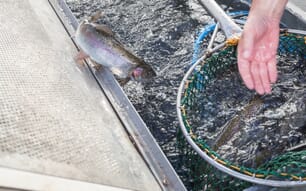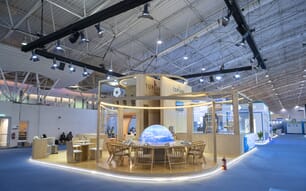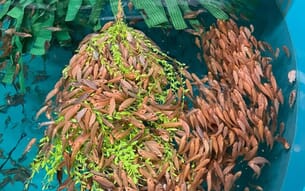Originally delivered at the LARVI fish and shellfish larviculture symposium last month, the presentation is entitled Progress and trends in Mediterranean Marine Fish Hatcheries. The Fish Site caught up with the report’s author, Isabel Represas of INVE Aquaculture, to find out more about the significance of her findings and how the marine finfish industry – both in the Mediterranean and further afield – was evolving.
What were the most significant trends you noted in Europe in the 2013-17 period?
There were two major trends, the first of which has seen that structure of the seabass and sea bream industry consolidate leading to an increase in the size of many hatcheries – the number of operational hatcheries with producing 35 million fry or more annually has increased from 13% to 20%.

© INVE Aquaculture
The second involves the boom in production of cleanerfish species in northern Europe, which are used as a natural tool for biological control of sea lice in salmon industry. Is the first time that two species, lumpfish and ballan wrasse, have been cultured for the biocontrol of parasites.
What are the major factors behind the decrease in the production costs and the increased survival rates of seabass and sea bream in hatcheries?
The optimization of production methods and protocols, an improvement in efficiency of systems and increasing levels of automation have resulted in better consistency in production numbers and quality. The increase in survival rates has been the main factor in reducing production costs.
Have these trends been mirrored in the grow-out phase for these species?
Not exactly. In recent years key performance indicators in the grow-out phase – such as mortality, growth and FCR – of seabass and bream have not advanced sufficiently. At INVE we believe this is down to the quality of the juveniles and therefore the hatcheries should not merely focus on improving survival and decreasing deformities. It’s possible to have two juveniles that appear the same, morphometrically and morphologically, but possess different potential and perform differently in the grow-out phase and this is what we want to analyze. As a result, INVE are working on a range of activities to target grow-out performance improvement via increasing fry quality.
In brief, the aim of this programme is to help improve the robustness of the fish as well as ensure the correct development of the larvae via cost-efficient tailor-made hatchery protocols. This can ensure the sustainable growth of aquaculture in the Mediterranean.

© INVE Aquaculture
How does the European marine finfish industry compare to the marine finfish industry in other parts of the world?
Finfish production in the Mediterranean is close to 370,000 tonnes, making it the largest production area of marine finfish worldwide, excluding China. It’s also an area where the industry has been investing heavily in farming technologies and automation to stay competitive, while quality, food safety and traceability have become critical factors. An environmentally friendly approach to aquaculture has become mandatory to maintain production licences and commercial viability.
How do you see the European marine finfish industry evolving in the next 5-10 years?
According to the recent FAO Report “Short-term projection of global fish demand”, the projection on European marine fish demand-supply gap in the 2020s will be 700,000 tonnes, so it would require a 31 percent annual growth to fill the gap.
Within this context I believe seabass and bream will continue to grow, applying strategies of VAP and differentiation, with Greece and Turkey remaining as the largest producers, followed by Spain and Italy.
At the same time diversification is needed to increase the variety of farmed fish species, to reduce the risks of monoculture practices. Seriola could be a promising new species, based on market development strategies, with good adaptation, rapid growth, large size and easy processing.
The intensification of production is directly linked to an increased incidence of disease outbreaks and this will be the biggest challenge facing the industry in the coming years. The introduction of stricter biosecurity and health management strategies, the increasing use of vaccinations and advances in genetics and nutrition will allow the further expansion in production.
Do you think marine finfish can learn from other aquaculture sectors?
The complexity of marine fish aquaculture is well-known and not easy to compare with other sectors, but I believe the salmon industry is a good example to be followed. In particular, looking at the organization of the sector, data sharing, marketing, branding, and the focus in value-added products.
Going from production-orientated to market-orientated will reduce the price volatility and give more solidity to the industry in the Mediterranean.
What inspired you to undertake the study?
INVE has field teams in every corner of the Mediterranean which allows us to stay up to speed with what is going on in the market, monitoring all important trends, innovations and breakthroughs. For many years now, we have collected field data covering elements such as species, production numbers, survival, and production techniques, and we keep records of the key figures as indicators of the evolution in the industry.
Sharing knowledge with our customers and the wider aquaculture community has always been our philosophy. We are committed to supporting fish farmers and sharing the technical knowledge as well as business knowledge and market knowledge, we believe this is the key to success and this is what inspired this study.

Other presentations
As platinum sponsor of the LARVI event INVE aquaculture’s team gave a range of other presentations, which are also available on request by emailing marcom@inveaquaculture.com.
These include:
- Alessandro Moretti: ‘Fry morphological and non-morphological factors affecting Mediterranean fish quality.’
- Roeland Wouters: “Advanced larval feeding protocols resulting in a reduction of Artemia cyst consumption without affecting the performance and quality of shrimp.”
- Peter De Schrijver: “Microbial management in marine fish and crustacean hatcheries.”
- Eva Bequé: “Alternative biosecurity concepts for living organisms entering marine hatcheries.”



